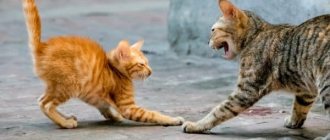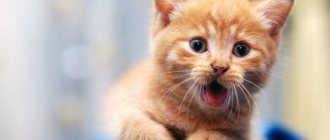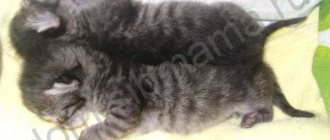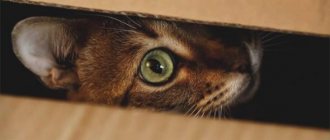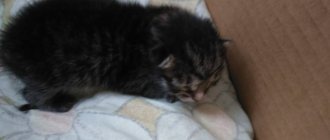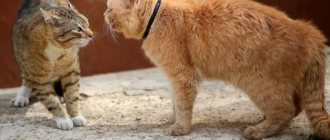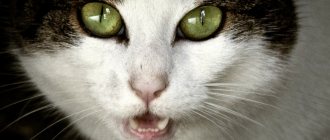First aid for newborns
Among domestic cats, stillbirth is not uncommon. Even under satisfactory housing conditions, the percentage of stillborn kittens ranges from 4 to 15%.
Very often, the reason why a cat’s kittens die is the inexperience and illiteracy of the animal owner. Often, newly born babies may seem lifeless. Newborns may not move or make any sounds and are often mistaken for stillborn. However, competently carried out resuscitation measures can save the baby’s life:
- First of all, it is necessary to free the kitten from the shell, this will allow him to breathe on his own.
- The umbilical cord should be pinched with your fingers at a distance of 2 cm from the tummy for a few seconds (squeezing the blood vessels) and cut with sterile scissors. The wound should be treated with an antiseptic.
Scissors, gauze pads and antiseptic are the necessary materials for giving birth to a cat.
- Your baby's nose and mouth may become clogged with mucus. In this case, it is necessary to empty the oral cavity and nasal passage using a small syringe.
Diapers and a syringe are important tools.
- After this manipulation, the cub is wrapped in a waffle towel and tilted head down to remove the remaining mucus.
- Mouth-to-mouth artificial respiration helps to revive weak kittens. This should be done with the help of devices: a straw, a small syringe, etc. You need to blow air into the mouth at intervals of 3 - 5 seconds in small portions, taking into account the size of his lungs.
- Carefully licking her kittens, the mother cat, at the level of instinct, carries out resuscitation of the weak cub. The owner can also imitate this behavior by using fingers wrapped in a sterile cloth for massage. Massage movements should be carried out on the head (from the forehead to the back), along the torso (from the tail to the neck) and on the tummy (in circular movements from the chest to the perineum). Manipulations should be carried out intensively.
- At home, ammonia has been successfully used to revive kittens. A cotton wool soaked in the preparation should be brought to the baby’s nose several times.
You should know that resuscitation measures can be carried out for no more than 5 - 7 minutes if there is no heartbeat, and no more than 20 minutes if there is a heart rhythm. We recommend reading the article about when you can sterilize a cat. From it you will learn about the best age to sterilize a cat and about periods in an animal’s life when sterilization should be delayed.
[custom_ads_shortcode1]
Causes of stillbirth in cats
There are many reasons why an animal gives birth to dead kittens. Conventionally, they can be divided into the following groups: 1. Genetic causes. This is a large group of factors that directly affects the viability of the offspring and is the reason why a cat gives birth to dead kittens:
- Hereditary factor. If there are cases of stillbirth on the maternal and paternal lines of the mother cat, then the likelihood of stillbirth increases sharply.
- Genetic abnormalities of fetal development (mutations and deformities).
- Inbreeding (mating of closely related lines) is one of the common causes of stillbirth.
- Blood group incompatibility. When breeding, this factor must be taken into account, since parental incompatibility leads to hemolytic disease of the newborn and stillbirth.
To date, three blood groups :
| Formed through the following pair of genes: A/A or A/B , where A is the dominant gene and suppresses the properties of B |
| Very rare and not yet fully studied. Please note that AB is a completely different blood type than A/B |
| formed through I/V genes |
2. Adverse factors during pregnancy:
- Injuries during pregnancy. Blows and bruises, falls from a height of a pregnant female often lead to the birth of dead offspring.
- The presence of diseases of an infectious or parasitic nature in the mother or father (chlamydia, listeriosis, toxoplasmosis, herpes, panleukopenia, etc.) is a common reason why a cat gave birth to dead kittens. In this case, diseases in animals can be asymptomatic, without obvious clinical signs or in the form of virus carriage.
Herpes on a cat's lip.
- Inflammatory diseases of the female reproductive system. Metritis, endometritis, inflammatory processes in the genitourinary area lead to disruption of pregnancy, the supply of nutrients and oxygen to the babies in the womb.
- Poor nutrition and maintenance of a pregnant cat. An inadequate and low-calorie diet of the female, a lack of vitamins and minerals are common reasons why a cat gives birth to dead kittens. Lack of physical activity and physical inactivity lead to oxygen starvation of the fetus in the womb.
3. Adverse factors during childbirth. Quite often, the cause of stillbirth is deviations in normal labor:
- Complications during childbirth (incomplete dilatation of the birth canal, prolonged labor) lead to kittens suffocating as a result of strong pushing and delay in the birth canal.
- The animal owner's inexperience in determining its viability is also often the reason why the baby is mistakenly considered stillborn. This group of reasons also includes incorrect actions (or inaction) of the owner to revive the kitten.
4. Other factors. The reasons for the birth of stillborn kittens can be not only genetic diseases, illnesses and injuries, but also other factors that must be taken into account:
- Number of previous pregnancies. Very often, non-living offspring are born to a primiparous cat, as well as to an animal with a small number of pregnancies. The more often an animal gives birth, the less likely it is to give birth to stillborn kittens.
- Mother's weight. A large cat is more likely to give birth to a stillborn litter than an animal of average weight. This is due to the fact that a thick fatty layer of internal organs, including the uterus, leads to hypoxia of the fetus in the womb.
The variety of causes and factors leading to stillbirth makes diagnosis and preventive measures difficult.
[custom_ads_shortcode2]
“Dream Interpretation: a cat gave birth to Kittens; I dreamed about why a cat gave birth to Kittens in a dream.”
Dream interpretation cat gave birth to kittens
The cat gave birth to kittens, according to the dream book - wealth in the family, unexpected income from somewhere outside. It is quite possible to become the owner of a large fortune or receive interest on a deposit.
The ability to interpret dreams is a valuable gift, because sometimes it is in dreams that the conscious mind gives us the deepest and most important clues.
Our experts will help you find out why a cat dreams of giving birth to Kittens in a dream, just write the dream in the form below and they will explain to you what it means if you saw this symbol in a dream. Try it!
In my dream, three cats gave birth, in a place familiar to me, and I kept trying to clean the floor and wanted to wash the kittens. One of the cats gave birth to only one kitten but was still pregnant. There was a feeling that she should give birth to more kittens.
I dreamed on Monday that I was walking along the road, and a red cat with newborn kittens was lying on the side of the road, I walked past them. On Tuesday I already dreamed that my cat, who had already died, gave birth to a lot of kittens, I remember the number 20. Her milk was not enough and I supplemented them and gave milk to the cat. Help me find out what these dreams are for.
Good day. I fell asleep at work for less than an hour and dreamed that in some kind of prison, like a swimming pool, I saw a cat, she went behind some boxes and immediately came out along with many kittens 4-6, supposedly gave birth) and out of nowhere two older ones appeared in my hands fluffy kittens and I begin to compare their sizes, those that were born are literally the size of a finger, and these two are normal kittens, I don’t remember the color of the small ones, but the ones I held were gray, they look like something out of a whiskey ad. Thanks in advance, I'll wait for your answer.
I assisted in giving birth to a cat. She gave birth to three kittens, red, gray and white with black spots. They were born right into my hands, wet, slimy, in a transparent bubble each, and
Source
Actions of the owner upon the birth of stillborn kittens
The owner of an animal is not always mentally prepared for the fact that childbirth ends in the birth of dead offspring. And the question of what to do if a cat’s kittens die is relevant in such a situation. First of all, the owner needs to carry out a series of resuscitation measures.
If the appropriate manipulations do not lead to the revival of the baby within 20 minutes, the animal can be considered dead. It must be isolated from the cat and wrapped in a plastic bag. If all kittens in a litter are stillborn, each corpse should be placed in a separate waterproof bag.
The owner's next step is to visit a veterinarian to autopsy the dead kittens and determine the cause of their death. As a rule, a pathological examination helps to identify causes of stillbirth such as: congenital anomalies in fetal development, infectious diseases, injuries during pregnancy and childbirth, etc.
After the mother cat has had a rest from giving birth, she and the father cat should also be shown to a veterinarian to determine the reasons that led to the birth of a stillborn offspring. Diagnostics will be aimed at identifying inflammatory processes in the cat’s reproductive system, incompatibility of blood groups, virus carriage or latent infection in both parents, etc.
[custom_ads_shortcode3]
Measures to prevent stillbirth in cats
Despite the variety of causes of stillbirth, you can significantly reduce the risk of stillbirth by following these tips:
- competent selection of parent pairs by breeders, taking into account the compatibility of blood groups and hereditary diseases;
- exclusion of closely related mating;
- diagnosis of latent infections of the parent couple before mating;
- vaccination according to the approved schedule of the parent couple;
- deworming (expulsion of worms and parasites) of the mother and father according to established periods before mating;
- exclusion from breeding of parents with developmental anomalies, mutations in the family;
- compliance with the norms and feeding regimen of a pregnant female;
- prevention of vitamin deficiencies, mineral deficiency;
- organizing proper maintenance for a pregnant cat (reducing stressful situations, organizing walks and active muscle activity);
- prevention of injuries during pregnancy.
Following these preventive measures will significantly reduce the risk of stillbirth in your cat.
The birth of dead kittens significantly overshadows a joyful event for the owner of a furry pet. An autopsy of stillborn offspring, diagnostic studies of a cat, and genetic analysis will help to understand the causes and factors of the sad event. Compliance with certain rules will help prevent and significantly reduce the risk of stillbirth in the future.
Among the reasons and factors are the following:
- Heredity. Mortality in the family (both maternal and paternal) greatly increases the likelihood of death.
- Genetic abnormalities. In the development of the fetus, deformities, mutations, and various disorders can be observed. Too frequent births, more than 2-3 times a year, can also lead to this.
- Imbreeding. If a closely related female and male mate, the life of the newborn kitten is at risk.
- Blood incompatibility. When breeding purebred cats, this is a key criterion. Blood type mismatches increase the risk of a stillborn kitten.
- Mutilation. Bumps and bruises, falls - these are factors characteristic of stray cats who are in constant danger. Painful contractions appear, and the cat may not give birth even in a day.
- Parasitic diseases. Individuals with chlamydia, toxoplasmosis, herpes, and inflammatory processes in the reproductive organs have little chance of a successful pregnancy outcome.
- Dietary disorders. The lack of the proper amount of vitamins and minerals interferes with the favorable development of the fetus and poses a threat to the life of the mother. The cat's activity decreases, and the fetus begins to become oxygen starved.
© shutterstock.
[custom_ads_shortcode1]
Hypoglycemia
Until the age of four weeks, the glycogen content in the kitten’s body is low. At this stage of life, muscle contractions, rather than the breakdown of glucose and brown fat, are responsible for heat production. Lack of glucose leads to hypoglycemia. A common cause is a large number of babies or insufficient milk from a nursing mother.
Glucose deficiency manifests itself:
- lethargy;
- passive behavior;
- convulsions;
- drop in body temperature.
At the initial stage, the baby can be saved by introducing additional complementary foods (natural milk substitute) and vitamins. If the disease is complicated, the veterinarian may prescribe an oral glucose solution. Injections under the skin at an early age are not recommended.
Hypothermia
The first weeks after birth, maternal warmth is vital for kittens, since the cubs’ own thermoregulation is far from perfect. Instinct dictates that mothers should not leave their furry babies alone for long periods of time. If the nest with babies is located in a cold place in the home, the cat can, on its own initiative, drag the offspring. The temperature in the room where babies grow should be maintained above 22 °C.
A kitten that finds itself far from the nest will have a gradual decrease in body temperature. The limit of 34 °C is a critical value at which the sucking reflex ceases to appear in a frostbitten kitten and digestive processes freeze. The mother will not care for such a child; without human help, the kitten will die. You can warm up your kitten using a heating pad and a warm blanket. Only after the animal’s temperature rises to 36 °C can you feed the baby formula using a pipette or bottle.
Attention! Giving food to a kitten (who is shivering) with a low temperature is dangerous. The milk will either enter the respiratory system or remain undigested inside the stomach. Both options will lead to immediate death.
Dehydration
Newborn animals must consume much more fluid than adults, as they rapidly lose moisture from the surface of the body. The average water consumption rate for a baby is 150 ml per kg of body weight, which is approximately twice as much as for an adult cat. Lack of milk or diarrhea leads to rapid development of dehydration. For these symptoms, your veterinarian will usually prescribe saline injections.
What to do if a kitten is born dead?
When a cat gives birth to dead kittens, it is mainly a moral blow for the owner. The first step is postpartum resuscitation measures. In some cases, this helps to save the kitten within 15-20 minutes after birth:
- The kitten should be turned down: the bubble is eliminated, which will leak bile from the mouth and lungs. Remains can be sucked out using a syringe.
- Two exhalations are made from the kitten’s mouth and nose. The mouth should completely cover the baby's face.
- You can check your heartbeat with a stethoscope. The chest is compressed with light pressure between the index finger and thumb.
As practice shows, if a cat gives birth to dead kittens, it is not possible to carry out resuscitation operations due to the lack of skills and appropriate equipment. In addition, we must not forget that diseases of a dead fetus can be transmitted to the cat's owner.
If there is no result, the dead baby is isolated from the mother and wrapped in a bag. When there is not one dead kitten, but several, each is isolated separately.
© shutterstock The second step is consultation with a veterinarian. The specialist will perform an autopsy of the dead fetus and identify the factors that influenced the death. The female and male (if possible) should be seen by a doctor after two to three days, when the cat has recovered from the birth. The veterinarian’s task is to identify or refute the presence of inflammation in the reproductive part of the body and, if necessary, prescribe treatment.
[custom_ads_shortcode2]
How to protect future offspring?
You can help your cat give birth to kittens alive and healthy through pregnancy prevention and preliminary preparation:
- competent choice of a male means compatibility of blood groups, absence of hereditary diseases and cases of stillbirth in ancestors;
- It is not recommended to allow mating of related individuals;
- periodic diagnostics of a pet will identify infectious formations and reproductive problems in advance;
- in a veterinary clinic you can carry out deworming - elimination of parasites and worms;
A cat needs care during pregnancy. This concerns nutrition and safety: the slightest injury can become critical for the fetus.
When a cat gives birth to a dead kitten, this is a signal that you need to find out what reasons provoked this development of events. This will allow you to prevent the repetition of an unpleasant situation in the future, and sometimes even save the cat itself. Immediately after the birth of kittens, you can try to bring them back to life, following generally accepted rules.
It is important to understand that the risks of stillbirth in purebred cats are higher than in outbred cats. These are the statistics.
[custom_ads_shortcode3]
Research in the field
Veterinarians warn that the fact that one kitten was born does not indicate that the cat and its offspring are in danger. Often, pregnancy is multiple, so after a stillbirth, a cat can give birth to live babies.
Veterinary statistics collected over many years of practice indicate that the mortality rate among offspring of purebred cats is higher than that of outbred cats. At the same time, 7% of babies die in utero, 9% - until the 2nd week of life, 9% - 3 weeks or a month after birth. But only 75% of 4-month-old fluffy babies reach one year of age. According to general data, among pets of any breed, the number of cases where a cat gives birth to dead kittens is from 4 to 15%.
There is a small chance that some babies will be born dead or die soon after.
[custom_ads_shortcode2]
Congenital malformations
As the name suggests, these are severe defects of an anatomical or physiological nature that are present in the kitten even before its “official” birth. They can be caused either by the action of bad genetics or by certain substances (medicines), pathogens, or negative environmental factors.
The following types of birth defects are relatively typical for cats:
- Cleft palate.
- Umbilical hernia.
- Skeletal defects.
As for the umbilical hernia, it should not be considered a “moderate defect”. In severe cases, half (or even all) of the intestinal loops are inside the hernial sac, which is why at birth they are inevitably pinched and, as a rule, torn. The kitten dies either from severe painful shock or from blood loss. Alas, it is almost impossible to save such a baby.
With relatively severe birth defects, kittens have little chance of being born alive, and the likelihood of their subsequent survival is extremely low. More moderate disorders can either lead to the death of kittens soon after birth, or become apparent much later (even the same Persians have been known to live to the age of three or more years with a liver no more than ¼ of its normal size).
The risk of genetically determined developmental defects increases sharply in cases of inbreeding, which is also more common in purebred animals.
It is believed that normal weight for most breeds varies from 90 to 100 grams, but some cats of eastern origin give birth to smaller cubs, and larger animals (for example, Maine Coon), accordingly, give birth to larger ones.
Despite this, statistics show that pets born with a body weight of 75 grams or more. and less, they will not live long (or they will be born already dead).
Main provocateurs
The reasons why a kitten dies or all offspring die in the first hours or days of life include the following:
- Genetic factors: heredity, when there are cases of dead kittens being born in the parents’ family;
- developmental defects - mutations and deformities;
- contact with close relatives;
- incompatibility of feline blood types.
- injuries, falls from height;
- complications in the form of insufficient opening of the birth canal;
- the presence of successful pregnancies or absence, for example, for those who give birth for the first time, the risks of stillbirth are higher;
[custom_ads_shortcode3]
First aid
If the owner has not previously helped the pet in this process, then he may consider a completely alive and simply inactive baby to be dead.
Often a provocateur for the fact that small kittens have died is the fact of inexperience or illiteracy of the owner of the giving birth pet. Sometimes a person is not able to distinguish between the presence and absence of signs of life in a baby. Newborn kittens may not move or meow, causing the owner to decide that the baby is dead. To prevent a cat from giving birth to dead kittens, it is important to ensure safe gestation conditions, contact a veterinarian for assistance during childbirth, and also be able to provide first aid to newborn babies.
The algorithm of actions is as follows:
- Remove the baby from the hymen, allowing it to breathe.
- You can pinch the umbilical cord with your fingers, at a distance of 2 cm from the tummy, and cut it off with sterile scissors.
- Wash the wound with an antiseptic.
- Free the mouth and nose from mucus using a small syringe, and then turn the head down.
- Help the kitten breathe by breathing “mouth to mouth” according to the rules:
- take a straw;
- insert into baby's mouth;
- blow in a little air every 3-5 seconds.
To cut the umbilical cord, you must use a sterile instrument.
Usually, the mother cat frees the hymen by licking the lumps that appear. But, if this is not possible (the pet has abandoned the baby or is busy giving birth to other kittens), you can imitate the mother’s movements. To do this, wrap your finger in a napkin and do a light massage: from the forehead to the back, from the tail to the neck and along the area from the throat to the tail on the stomach.
Some breeders use ammonia to revive it by placing a piece of cotton wool soaked in a small amount of solution to the spout. Trying to bring a baby back to life if it smells bad initially is not advisable, since the newborn kitten died in the womb.
In this situation, baby massage can be effective.
Resuscitation is carried out for no more than 20 minutes in the presence of heartbeats, but up to 7 minutes in the absence of a pulse.
[custom_ads_shortcode1]
Signs of labor that will take place in 1-2 days
At this point, manifestations depend on how attached the cat is to its owners. If she completely trusts people, then it is not difficult to notice the signs of an imminent birth. The main one is an invitation to join in the process of childbirth. The cat begins to constantly follow the person and often call him to follow him, taking him to the box in which lambing will occur. She can lie down on the bedding with her belly up and remain in this position until the owner leaves. If you look closely, at this moment you can see the kittens moving inside the belly. They will mix into the desired position gradually, not in 1 day.
Also, the approaching moment of the birth of kittens is indicated by the fact that the pet begins to wash itself frequently, actively licking the area under the tail. She can even completely lick off all the fur in the genital area, which makes the birth of offspring easier, since the kittens will not have to get tangled in their mother’s fur coat.
From this point on, all the tools that may be required when receiving kittens should be prepared. You also need to have the phone number of a veterinarian on hand, who can immediately arrive and provide all the necessary assistance, including surgical intervention.
What to do with dead newborns?
If first aid for stillbirths does not help and the fact of death is confirmed, a number of measures need to be taken. When one small cat is born dead, the baby’s corpse should be isolated from the cat, placed in a plastic bag, and the other (living) ones should be given proper care and warmth. If a cat gives birth to a kitten whose paws are twisted, you need to put it in a warm, secluded place, since the mother often refuses the weakened crumbs, and sometimes even eats them. If everyone is stillborn, it means that each baby needs to be placed in different containers, and then it is important to go with the burden to the veterinarian to find out what caused the death.
After the cat gives birth and recovers a little, she needs to be shown to a doctor. The specialist will perform an autopsy of the dead kittens, examine the mother cat and issue an opinion regarding the provocateurs of the unpleasant situation. If the cause is infection, the pet needs to be treated urgently.
When the problem is hereditary, veterinarians often suggest spaying the cat. If mutations and developmental anomalies are detected, doctors recommend reconsidering applicants for paternity.
[custom_ads_shortcode2]
Varieties and their symptoms
One of the types of miscarriages that pose the least danger to your pet is fetal resorption in the early stages of pregnancy. In fact, the process may go unnoticed by you. The fruits do not necessarily all dissolve; sometimes some of them continue to develop normally. Much more serious is intrauterine fetal death, which can occur at any stage of pregnancy.
As for intrauterine fetal death without miscarriage, this is the most serious problem. In this case, your pet begins to bleed heavily, as well as purulent discharge (key symptoms). In addition, the cat refuses food, begins to vomit, and the temperature rises. The only sure way out is to contact a specialist as soon as possible.
Why was a kitten born dead? Why could a kitten be born dead?
Every owner of a furry purr becomes very nervous when it comes to childbirth, especially if the cat has to go through this process for the first time, and this anxiety is completely justified, because accidents happen much more often than it seems at first glance.
And in order to be safe from an unfavorable course of the birth process (so that a dead kitten is not born), it is recommended to carefully monitor the cat’s condition throughout pregnancy, giving great importance, first of all, to its nutrition. The fact is that one of the most common reasons why a cat gives birth to dead kittens may be an incorrectly selected diet, because a lack of important vitamins, minerals and nutrients, chronic malnutrition or consumption of harmful foods can play a role in this important issue. Moreover, if this kind of menu is still capable of, at the very least, supporting the basic processes of the life of the fetus during the period of its intrauterine development, then not every kitten can survive the stress and extreme stress from the birth itself, which results in an increased mortality rate of newborns during lambing.
In addition, we should not forget about the fact that careless handling of an animal can have a negative impact on pregnancy and the further process of childbirth, and children’s games with a pet during the period when she is expecting offspring are especially often to blame. For example, any awkward movement, an accidental blow or bruise in the abdominal area, as well as too much squeezing can provoke the death of the fetus and, as a result, premature birth. Moreover, this option is far from the worst, because things will be much worse if labor does not begin, as a result of which the decomposition of dead kittens will occur right in the womb.
In this case, a serious threat arises for the woman in labor herself, since further decomposition processes will provoke a phenomenon such as pyometra (inflammation of the uterine mucosa), the consequence of which is sepsis with all the ensuing consequences.
That is why it is so important to listen to the movements and heartbeat of the fetus all the time, and it is best for a veterinarian to monitor this, so it would not be amiss to examine the animal in a veterinary clinic from time to time, especially if it has experienced some kind of stressful situation (fright, fall, bruise and the like). In general, it is recommended to seek the help of a specialist not only during pregnancy, but also directly during lambing, unless of course we are talking about the second and all subsequent births if the first one is successful. The fact is, when answering the question of why kittens were born dead, experts often refer to incomplete dilation of the birth canal, which usually happens in cases when an animal gives birth for the first time. It is this pathology that leads to the fact that absolutely healthy kittens simply suffocate, falling into the birth canal when the pelvic bones of the animal are not sufficiently diverged.
Each attempt greatly complicates an already difficult situation, because spasm makes the space of the birth canal even narrower. In addition, too weak labor activity or its absence as such can negatively affect the lambing process, and the only way out of this situation may be timely stimulation, which can only be carried out with the help of appropriate drugs intended for intramuscular use. Moreover, it is quite natural that only a specialist can cope with the task, so there is another compelling reason to ensure his presence at least during the first lambing of the pet. When looking for a possible reason why kittens were born dead, we should not forget about such a fairly common factor as various types of infectious diseases that can have an extremely negative impact on intrauterine development and the vital functions of fetuses.
And in order to avoid such a development of the situation, it is recommended that the animal be examined at a veterinary clinic for the presence of infections immediately before mating, as well as during pregnancy, since some infections can be viral in nature.
When a cat gives birth to a dead kitten, this is a signal that you need to find out what reasons provoked this development of events. This will allow you to prevent the repetition of an unpleasant situation in the future, and sometimes even save the cat itself. Immediately after the birth of kittens, you can try to bring them back to life, following generally accepted rules.
It is important to understand that the risks of stillbirth in purebred cats are higher than in outbred cats. These are the statistics.
[custom_ads_shortcode3]
Negative environmental factors
Environmental factors are an important factor that directly influences the possibility of stillbirth. These include:
- Sudden changes in external temperature in the last stages of pregnancy. In such cases, the cat’s body may not be able to cope with normal thermoregulation, and therefore the kittens will suffer from hypothermia already in the womb. This has an extremely negative effect on the development of fruits. Hypothermia is also deadly for babies whose body weight is less than normal (as already indirectly mentioned above). What to do? To try to increase the chances of survival of such a baby, hold it in your hands for at least a few minutes. Practice proves that “warmed up” pets are slightly more likely to not die immediately after birth.
- Failure to comply with basic sanitary and hygienic standards when caring for a cat.
- Crowded housing of animals. This factor is especially typical for shelters and pet stores. Under such conditions, the likelihood of developing stress increases significantly, and the cat receives less nutrients, unable to fully compete for food with other animals.
- Stress and mental disorders of the cat itself (yes, animals also have mental problems). Under the influence of these factors, the cat itself can kill and even eat all the kittens that have just been born. In addition, in such cases, the mother very often abandons the cubs and refuses to feed them. If the owner does not take up artificial feeding (and this is an extremely complex and time-consuming procedure), the pets are doomed to death.
Research in the field
Veterinarians warn that the fact that one kitten was born does not indicate that the cat and its offspring are in danger. Often, pregnancy is multiple, so after a stillbirth, a cat can give birth to live babies.
Veterinary statistics collected over many years of practice indicate that the mortality rate among offspring of purebred cats is higher than that of outbred cats. At the same time, 7% of babies die in utero, 9% - until the 2nd week of life, 9% - 3 weeks or a month after birth. But only 75% of 4-month-old fluffy babies reach one year of age. According to general data, among pets of any breed, the number of cases where a cat gives birth to dead kittens is from 4 to 15%.
There is a small chance that some babies will be born dead or die soon after. Return to contents.
[custom_ads_shortcode2]
Important Notes
Firstly, we note that the fact of the birth of a stillborn kitten (even if it is the first) does not mean something catastrophically dangerous. Cats are prolific animals, and therefore, after a dead cub, they may well be born alive and healthy. Moreover, experienced breeders probably know that a certain percentage of waste always occurs.
Alas, inexorable veterinary statistics accumulated by practicing specialists around the world indicate that in purebred animals the risk of giving birth to dead kittens is always higher (and significantly) than in outbred “murks”. This is especially true for Persians: in some cases, up to 7% of kittens are born dead in pets of this breed, and another 9% of cubs die within the first week of life.
In general, it is the Persians who collect the most sad statistics: it is believed that if 75% of kittens are alive by the third week of life, then this is a very good result. It often happens that more than half of all newborns die. This deplorable situation is associated with a huge number of genetically transmitted diseases. There are cases where a third of the entire litter was born with severe liver pathologies (including the complete absence of this organ).
Secondly, it is necessary to distinguish between cases of stillbirth and infant death. Remember that in situations where a kitten dies within the first hours after birth (or even the first days), it is also customary to talk about “stillbirth”.
Thirdly, it is necessary to distinguish between situations when kittens were born dead, being still in the womb, and cases when the cubs, initially healthy (at least partially), died directly during the birth process.
Main predisposing factors
We list the most common causes of stillbirth encountered in veterinary practice:
- Hypoxia (lack of oxygen). This is a very common pathology in cases of protracted labor, when the kitten’s umbilical cord, which supplies its body with oxygen, is pinched in the birth canal. It is believed that in cases where a kitten remains in the birth canal for more than ten minutes, unable to be born, the risk of its death increases to almost 90%. Due to severe hypoxia, a kitten may be born alive, but you shouldn’t experience much joy from this: such pets often cannot even suck their mother’s milk. They subsequently develop serious developmental problems. As a rule, after some time they die anyway.
- Injuries received by babies directly during childbirth often lead to similar results. Studies have shown that cats with “extremes” of anatomical development (long-suffering Persians are especially “distinguished”) experience more problems during the birth process. Most likely, this is a consequence of the combination of the kittens’ large heads and narrow pelvises in cats of this breed.
- The percentage of stillborn kittens in litters of primiparous and old cats is much higher. Such animals are either inexperienced, or their body is not able to ensure the normal development of fruits. In addition, in old pets there are very frequent cases of severe uterine atony, which is why kittens are born for a long time, often getting “tightly” stuck in the birth canal.
It has been observed that cases of stillbirth are much more common in animals suffering from obesity. In addition, some cats produce milk long before birth, which (if it is not sucked out mechanically) leads to mastitis. Inflammation of the mammary glands significantly increases both the risk of stillbirth and the likelihood of infant death. Mastitis milk, saturated with decay products and pathogenic microflora, is not the best food for the delicate stomachs of kittens that have just been born.
Main provocateurs
The reasons why a kitten dies or all offspring die in the first hours or days of life include the following:
- Genetic factors: heredity, when there are cases of dead kittens being born in the parents’ family;
- developmental defects - mutations and deformities;
- contact with close relatives;
- incompatibility of feline blood types.
- injuries, falls from height;
- complications in the form of insufficient opening of the birth canal;
- the presence of successful pregnancies or absence, for example, for those who give birth for the first time, the risks of stillbirth are higher;
Return to contents.
[custom_ads_shortcode3]
First aid
If the owner has not previously helped the pet in this process, then he may consider a completely alive and simply inactive baby to be dead.
Often a provocateur for the fact that small kittens have died is the fact of inexperience or illiteracy of the owner of the giving birth pet. Sometimes a person is not able to distinguish between the presence and absence of signs of life in a baby. Newborn kittens may not move or meow, causing the owner to decide that the baby is dead. To prevent a cat from giving birth to dead kittens, it is important to ensure safe gestation conditions, contact a veterinarian for assistance during childbirth, and also be able to provide first aid to newborn babies.
The algorithm of actions is as follows:
- Remove the baby from the hymen, allowing it to breathe.
- You can pinch the umbilical cord with your fingers, at a distance of 2 cm from the tummy, and cut it off with sterile scissors.
- Wash the wound with an antiseptic.
- Free the mouth and nose from mucus using a small syringe, and then turn the head down.
- Help the kitten breathe by breathing “mouth to mouth” according to the rules:
- take a straw;
- insert into baby's mouth;
- blow in a little air every 3-5 seconds.
To cut the umbilical cord, you must use a sterile instrument.
Usually, the mother cat frees the hymen by licking the lumps that appear. But, if this is not possible (the pet has abandoned the baby or is busy giving birth to other kittens), you can imitate the mother’s movements. To do this, wrap your finger in a napkin and do a light massage: from the forehead to the back, from the tail to the neck and along the area from the throat to the tail on the stomach.
Some breeders use ammonia to revive it by placing a piece of cotton wool soaked in a small amount of solution to the spout. Trying to bring a baby back to life if it smells bad initially is not advisable, since the newborn kitten died in the womb.
In this situation, baby massage can be effective.
Resuscitation is carried out for no more than 20 minutes in the presence of heartbeats, but up to 7 minutes in the absence of a pulse. Return to contents.
[custom_ads_shortcode1]
